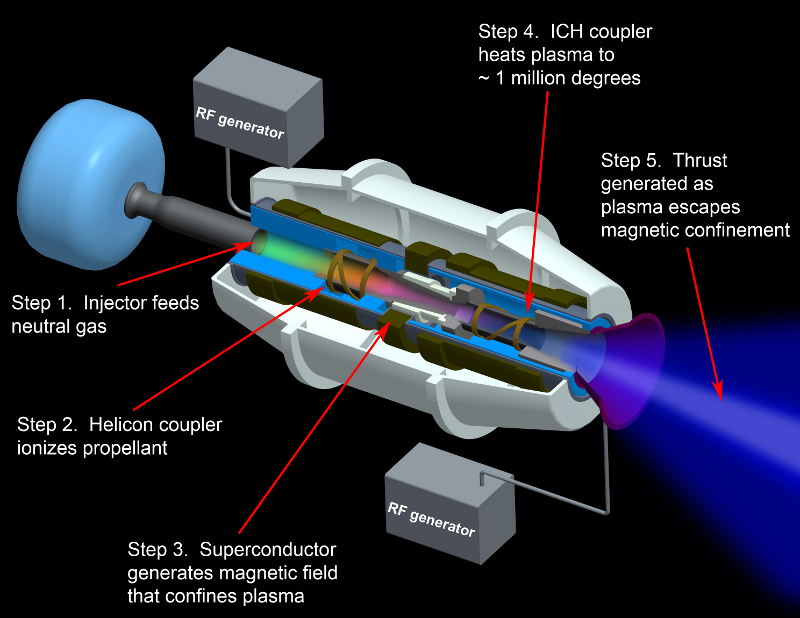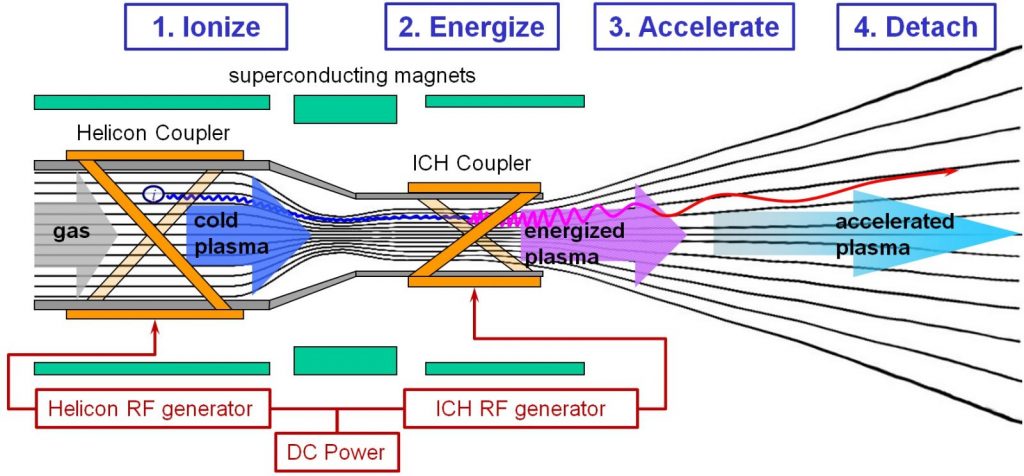The VASIMR (Variable Specific Impulse Magnetoplasma Rocket) concept originated in 1977 with former NASA astronaut Franklin Chang Díaz, who has been developing the technology ever since.
An electric power source ionizes hydrogen, deuterium, or helium fuel into a plasma by stripping away electrons. Magnetic fields then direct the charged gas in the proper direction to provide thrust.
“A rocket engine is a canister holding high-pressure gas,” Chang Diaz explained. “When you open a hole at one end, the gas squirts out and the rocket goes the other way. The hotter the stuff in the canister, the higher the speed it escapes and the faster the rocket goes. But if it’s too hot, it melts the canister.”
The VASIMR engine is different, Chang Diaz explained, because of the fuel’s electrical charge: “When gas gets above 10,000 [kelvins], it changes to plasma – an electrically charged soup of particles. And these particles can be held together by a magnetic field. The magnetic field becomes the canister, and there is no limit to how hot you can make the plasma.”
Every part of a VASIMR engine is magnetically shielded and does not directly contact plasma, increasing durability. Additionally, the lack of electrodes eliminates the electrode erosion that shortens the life of conventional ion thruster designs.
The propellant, a neutral gas such as argon or xenon, is injected into a hollow cylinder surfaced with electromagnets. On entering the engine, the gas is first heated to a “cold plasma” by a helicon RF antenna/coupler that bombards the gas with electromagnetic energy, stripping electrons off the propellant atoms and producing a plasma of ions and free electrons. By varying the amount of RF heating energy and plasma, VASIMR is claimed to be capable of generating either low-thrust, high–specific impulse exhaust or relatively high-thrust, low–specific impulse exhaust. The second phase of the engine is a strong electromagnet positioned to compress the ionized plasma in a similar fashion to a convergent-divergent nozzle that compresses gas in traditional rocket engines.
A second coupler, known as the Ion Cyclotron Heating (ICH) section, emits electromagnetic waves in resonance with the orbits of ions and electrons as they travel through the engine. Resonance is achieved through a reduction of the magnetic field in this portion of the engine that slows the orbital motion of the plasma particles. This section further heats the plasma to greater than 1,000,000 K (1,000,000 °C; 1,800,000 °F) —about 173 times the temperature of the Sun‘s surface.
The path of ions and electrons through the engine approximates lines parallel to the engine walls; however, the particles actually orbit those lines while traveling linearly through the engine. The final, diverging, section of the engine contains an expanding magnetic field that ejects the ions and electrons from the engine at velocities as great as 50,000 m/s (110,000 mph).
Advantages
In contrast to the typical cyclotron resonance heating processes, VASIMR ions are immediately ejected from the magnetic nozzle before they achieve thermalized distribution. Based on novel theoretical work in 2004 by Alexey V. Arefiev and Boris N. Breizman of University of Texas at Austin, virtually all of the energy in the ion cyclotron wave is uniformly transferred to ionized plasma in a single-pass cyclotron absorption process. This allows for ions to leave the magnetic nozzle with a very narrow energy distribution, and for significantly simplified and compact magnet arrangement in the engine.
VASIMR does not use electrodes; instead, it magnetically shields plasma from most hardware parts, thus eliminating electrode erosion, a major source of wear in ion engines. Compared to traditional rocket engines with very complex plumbing, high performance valves, actuators and turbopumps, VASIMR has almost no moving parts (apart from minor ones, like gas valves), maximizing long term durability.
Disadvantages
According to Ad Astra as of 2015, the VX-200 engine requires 200 kW electrical power to produce 5 N of thrust, or 40 kW/N. In contrast, the conventional NEXT ion thruster produces 0.327 N with only 7.7 kW, or 24 kW/N. Electrically speaking, NEXT is almost twice as efficient, and successfully completed a 48,000 hours (5.5 years) test in December 2009.
New problems also emerge with VASIMR, such as interaction with strong magnetic fields and thermal management. The inefficiency with which VASIMR operates generates substantial waste heat that needs to be channeled away without creating thermal overload and thermal stress. The superconducting electromagnets necessary to contain hot plasma generate tesla-range magnetic fields that can cause problems with other onboard devices and produce unwanted torque by interaction with the magnetosphere. To counter this latter effect, two thruster units can be packaged with magnetic fields oriented in opposite directions, making a net zero-torque magnetic quadrupole.
The required power generation technology for fast interplanetary travel does not currently exist and is not feasible with current state-of-the-art technology.
Chang Diaz has pointed out that hydrogen would be an advantageous fuel for the VASIMR engine because the spacecraft would not have to lift off carrying all the fuel it needs for the journey.
“We’re likely to find hydrogen pretty much anywhere we go in the Solar System,” he said.
A spacecraft using conventional chemical rockets would take eight months to get to Mars during opposition. However, the VASIMR engine would make the journey in as little as 39 days.
Chang Diaz explained: “Remember, you are accelerating the first half of the journey – the other half you’re slowing, so you will reach Mars but not pass it. The top speed with respect to the Sun would be about 32 miles per second [or 51.5 km/s]. But that requires a nuclear power source to heat the plasma to the proper temperature.”
The use of nuclear power in space is not without its controversy. In 1997, there was widespread public concern when NASA’s Cassini probe, which carried a plutonium battery, made a flyby of Earth to perform a gravity assist. Although NASA denied that the risk to the public, should an accident occur, was no greater than that posed every day by other sources of radiation, some scientists, including the popular theoretical physicist Michio Kaku, disagreed.
In April 1970, the Atomic Energy Commission was deeply concerned about the return of Apollo 13 to Earth. Where an Apollo mission would usually leave the lunar module’s descent stage on the Moon, the unsuccessful Apollo 13 dropped its lunar module Aquarius, with its plutonium-powered scientific experiments, into the ocean, raising concerns about radioactive contamination.
Elon Musk, CEO of Space Exploration Technologies Corporation (SpaceX), is skeptical about the viability of the VASIMR engine. One reason is the concern about radioactive debris falling to Earth in the event of an accident.
Musk is also skeptical that the VASIMR engine would be a significant improvement over chemical rockets, stating: “So people like Franklin – basically it’s a very interesting ion engine he’s got there, but it requires a big nuclear reactor. The ion engine is going to help a little bit, but not a lot in the absence of a big nuclear reactor.” Musk also points out that the big nuclear reactor would add a lot of weight to a rocket.
Chang Diaz dismisses the concerns about nuclear reactors in space, stating: “People are afraid of nuclear power. Chernobyl, Three Mile Island, Fukushima – it is a little misunderstood. But if humans are truly going to explore space, we eventually will have to come to grips with the concept.”
Another vocal critic of the VASIMR engine is Robert Zubrin, president of The Mars Society, who designed the Mars Direct plan to colonize Mars and wrote the popular book The Case For Mars. He has gone as far as to call the VASIMR engine a “hoax”. Zubrin wrote in SpaceNews: “To achieve his much-repeated claim that VASIMR could enable a 39-day one-way transit to Mars, Chang Diaz posits a nuclear reactor system with a power of 200,000 kilowatts and a power-to-mass ratio of 1,000 watts per kilogram. In fact, the largest space nuclear reactor ever built, the Soviet[-era] Topaz, had a power of 10 kilowatts and a power-to-mass ratio of 10 watts per kilogram. There is thus no basis whatsoever for believing in the feasibility of Chang Diaz’s fantasy power system.”
Chang Diaz, however, says in his paper: “Assuming advanced technologies that reduce the total specific mass to less than 2 kg/kW, trip times of less than 60 days will be possible with 200 MW of electrical power. One-way trips to Mars lasting less than 39 days are even conceivable using 200 MW of power if technological advances allow the specific mass to be reduced to near or below 1 kg/kW.”
The 2011 NASA research paper “Multi-MW Closed Cycle MHD Nuclear Space Power Via Nonequilibrium He/Xe Working Plasma” by Ron J. Litchford and Nobuhiro Harada, indicates that such developments are feasible in the near future.
Whether the VASIMR engine is viable or not, in 2015, NASA awarded Chang Diaz’s firm – Ad Astra Rocket Company™ – a three-year, $9 million contract. Up to now, the VASIMR engine has fired at fifty kilowatts for one minute – still a long way from Chang Diaz’s goal of 200 megawatts.
In its current form, the VASIMR engine uses argon for fuel. The first stage of the rocket heats the argon to plasma and injects it into the booster. There, a radio frequency excites the ions in a process called ion cyclotron resonance heating. As they pick up energy, they are spun into a stream of superheated plasma and accelerated out the back of the rocket.


